PHILIP NELSON STONE
1886 - 1974
Contents of sections below:
Personal info, birth, baptism
Education
Occupations
Military service
World War I service?
Family info
Death and burial
Residences
Additional biographical info
Censuses and work history
Aquaduct
Prison keeper
General info on "The Tombs"
References and sources
Sources checked, nothing found
NAME in
full: Philip Nelson Stone6, 7, 17, 21
NICKNAMES: “Nels” (to parents and siblings);17 “Phil(?)”26
PHYSICAL DESCRIPTION: (while in the military, 1908-1913, ages 22 to 27) dark brown hair, blue eyes, “ruddy” complexion, height 5 feet 9 inches.1, 2 Tall, medium build, gray eyes, brown hair (1917, age 31)21 “Portly” (1930s, in his 40s).27
PHOTO: None available
SIGNATURE:4-3, 4-6, 4-30
![]()


BIRTH date: 26 June 18867, 11, 21 (24 June 188647)
BIRTH place: Nyack, Rockland County, NY;1, 2, 6, 7, 21 possibly at/near his (maternal?) grandparents’ house.45
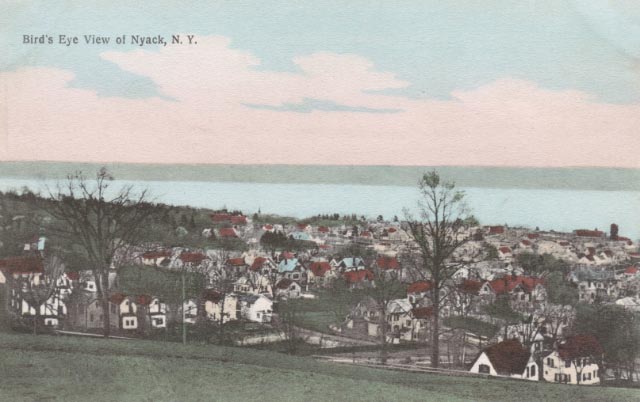 |
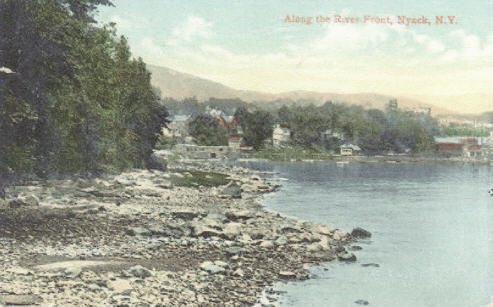 |
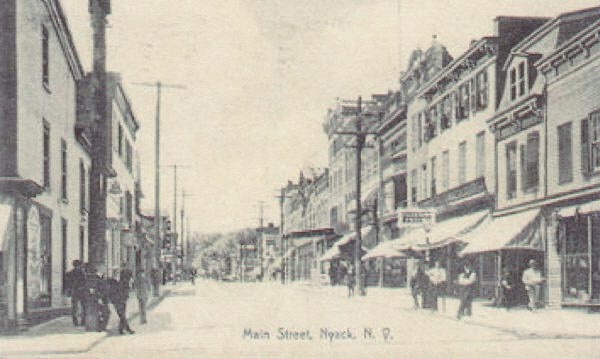 |
Old views of Nyack, New York, where Philip Nelson Stone was born. |
FATHER'S name in full: Edwin Bosworth Stone6, 7, 11, 19
MOTHER'S name in full: Margaret (“Maggie”) Demare6, 7, 11
BAPTISM: 22 August 1886, Grace Episcopal Church, Nyack, NY; parents Edwin and Maggie Stone; sponsors “Jacob Demarest and his sister and the Mother”47
EDUCATION: Unknown. His son claimed he had little formal education.27 His nephew told me that his Uncle Philip had taught him how to use a slide rule.45
Earned Certificate of Proficiency, Artillery Course, Coast Artillery School for Enlisted Specialists, U.S. Army, Fort Monroe, Virginia (August 1911-August 1912)40, 42
Completed eight-week course at the New York City Department of Correction keepers’ training school in late 1931-Jan. 1932. There keepers (prison guards) were taught marksmanship, how to disarm an assailant, how to search a prisoner, how to administer first aid, etc.26
OCCUPATION(S): Farmer,1 soldier,2 railroad worker—flagman,20 conductor48 and freight brakeman6, 20, 21 (for the New York Central Railroad in New York City21). Worked on the construction of the aqueduct into New York City17 and for the Board of Water Supply Police for New York City [most probably for the Schoharie Reservoir and/or Shandaken Tunnel projects near Gilboa, NY where he lived in 1924]. Worked many jobs to support himself and family during the Depression;17 [including?] milk delivery man.17 Finally: prison guard (“keeper”),11, 15, 26 New York City Dept. of Correction.17 Became a member of the New York City Employees’ Retirement System on 11 June 1923.46 Was working at the New Hampton (Orange County) men’s reformatory (“Hampton Farms”), 65 miles outside New York City, in December 1925;27 by January 1932 he had transferred to the position of keeper at the Greycourt women’s farm colony, the other New York City reformatory in Orange County, located near Chester, NY.26, 27 He ended up his career by eventually moving to New York City and was Deputy Warden at “The Tombs.”17 After retiring (from the New York City Employees’ Retirement System on 1 September 195446) he moved to the south of Texas.
MILITARY SERVICE: Coast Artillery Corps (U.S. Army), 26 August 1908 - 28 April 1913.
Philip N. STONE (age 22 years, two months, occupation: “farmer”)1 enlisted in the U.S. Army at Fort Slocum, NY (on Davids Island in Long Island Sound, the largest recruitment depot east of the Mississippi) on 26 August 1908 and served with the Coast Artillery Corps (C.A.C.), Company 167, stationed at Fort Totten, NY (on Willet’s Point in Queens, on Long Island Sound) from 26 September 1908 to 15 February 1910.22 At that time the Army’s Coast Artillery Corps had become the most technically advanced branch of the service, with the mission of guarding the seacoasts of the United States, primarily from forts in key ports.
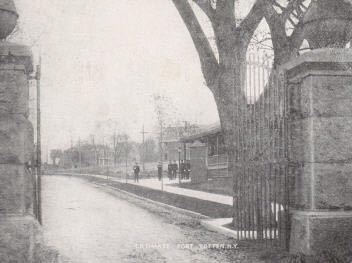 |
Entrance gate, Fort Totten, New York, circa 1907. |
He was a Private but qualified as First Class Gunner on 12 May 1909. One of his first excursions after enlisting was participating (parading?) with his company in the 225th Founders’ Day celebration in Philadelphia, Pennsylvania on 5 October 1908. He may have first met his future wife, Loretta EHMANN, while parading with his company in the Bronx the following spring, on Memorial Day, 31 May 1909. Was granted a one-month furlough, returning to the Company on 14 December 1909. Transferred to the 101st Company, C.A.C. on 15 February 1910.22
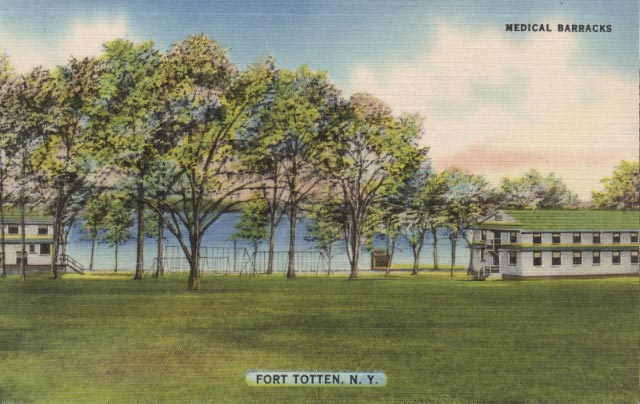 |
Medical barracks at Fort Totten, New York circa 1910. |
P.N. STONE served with the CAC, Co. 101, stationed in Fort Totten, NY, for over a year—from 15 February 1910 to 1 August 1911. Upon transfer to the 101st Company his rank changed from “Private” to “Musician.” He served the 101st as one of two company Musicians. (My surmise is that he was probably a bugler, as the other Musician he first joined, Jesse Ebersole from Ohio, was often sick in hospital and in fact had been absent/sick in the hospital since the middle of December 1909; subsequent second Musicians were at times sick and/or A.W.O.L. as well, leaving P.N. STONE as sole musician for the company. From what little I know of the Army, a bugler would be indispensable and could double as a drummer, but a drummer might not necessarily be able to double as a bugler. PN’s being a bugler might be a reason why his son later took up the trumpet as a youth. Indeed, perhaps the 1910 trumpet used by his son first belonged to P.N. STONE.)23
P.N. STONE’s Company participated once again in the Memorial Day parade in New York City, NY, Borough of Manhattan on 30 May 1910,23 at which time he may have met or visited Loretta EHMANN. (The Bronx did not officially become a borough separate from Manhattan until 1914.)
P.N. STONE also participated in the Company’s trip to Galveston, TX (8 March - 23 June 1911, traveling by ship along the east and Gulf coasts) for field training and exercises, including a 100-mile march to Houston and back.23 (This might be when he acquired his dream of returning to this part of Texas one day—carried out after his retirement nearly 50 years later.) At the end of the Texas trip, the Company returned again by ship to Fort Totten, New York with a stop at historic Fort Monroe (“The Gibraltar of the Chesapeake” near Hampton Roads and Newport News), Virginia.23 Fort Monroe had ties to Fort Totten at that time, since the School of Submarine Defense at Fort Totten had been relocated and united with the Coast Artillery School at Fort Monroe in 1907.41
On 27 June 1911 P.N. STONE requalified as a 1st Class Gunner.23
P.N. STONE was on a furlough from 24 July - 7 August 1911 and then was authorized for detached service at the School for Enlisted Specialists at Fort Monroe, VA, returning to the rank of Private from the rank of Musician while there for the year-long Artillery course.23, 40
After the U.S. Army had been divided into two distinct branches (the Field Artillery and the Coast Artillery) in 1907, a new Coast Artillery School was established at Fort Monroe. At that same time, Fort Monroe’s defenses were modernized with the emplacement of new mortars, “disappearing guns” and other state-of-the-art seacoast weapons.39 The Coast Artillery School for Enlisted Specialists there included instruction for electrical specialists (electrician sergeants), mechanical specialists (firemen), and artillery specialists (master gunners). The main objective in each of these three courses was “to make it as thoroughly practical and up-to-date as the limits of the school and service conditions permit. Extended theoretical and practical instruction was given in the artillery course covering mathematics, mechanical drawing, photography, physics, mechanics, optics, topography, seacoast engineering, as well as work with range tables and artillery materiel—special efforts being made to broaden the scope of all the subjects covered…”42
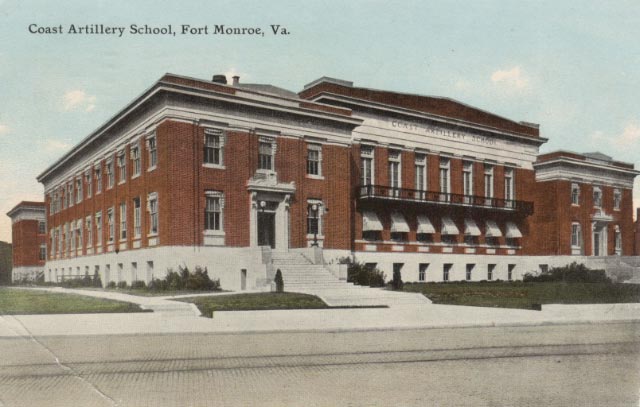 |
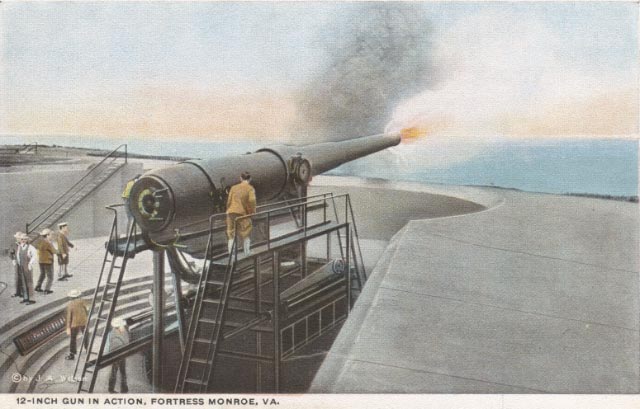 |
Postcard views of Fort Monroe from around the time Philip N. Stone was there. |
(Photos of Fort Monroe, Viriginia as it looked when Philip N. Stone was there.)
P.N. STONE lived in Building 161, a Coast Artillery School residence hall that opened during the 1911-1912 school term37 (and re-enlisted for the 101st CAC for another three-year hitch on 26 August 19112, 23). He was one of 57 enlisted men composing the classes at the beginning of the year. Seven were removed due to being unable to complete the work, two men left when their enlistments expired, six failed to achieve their certificates. Private Philip N. Stone, 101st Company, C.A.C. received his certificate of proficiency in the Regular Artillery Course at the end of the school year.42
It was recommended by the Commandant that the men who completed the course for whom there were no vacant positions “be utilized as Acting Master Gunners,…rather than allow them to return to company duty, where they will not be able to keep in touch with the duties they have learned at the school.” He also recommended that “men in the artillery course be permitted to pursue additional field exercises in surveying and triangulation work during the summer months. This work will be desirable to most students as it affords an outing and at the same time it makes them more familiar with and competent to do this kind of work.”42
On 1 August 1912 P.N. STONE transferred to the 99th Company of the Coast Artillery Corps stationed in Fort Morgan, Alabama, as Acting Master Gunner, “with permission to delay 30 days en route….”23, 24
Contrary to what the name implies, the rank of a Master Gunner had little to do with the actual firing of an artillery piece, but was a technical rating which required a high degree of skill.31 According to the 1913 Regulations for the Army of the United States, a Master Gunner of the Coast Artillery Corps ranked with a First Sergeant, below Sergeant Major, but above Color Sergeant, Sergeant, and Corporal—in other words, a responsible non-commissioned officer position which could not be reduced except by court-martial. The Service of Coast Artillery, 1909, describes the Master Gunner as “A Non-commissioned staff officer employed in Photographic work and seacoast engineering, in the preparation of tables, charts, and maps and for such other technical artillery duties as he may be qualified to perform.”31 [These engineering and charting skills, along with the surveying experience, may be what got P.N. STONE his later jobs with construction projects in and around New York City, for which no documentation has been yet found.]
During the period 31 August to 31 October 1912, P.N. STONE was listed as being on Special Detachment under the Artillery Engineer at Ft. Morgan. It is not known how long he served with the 99th, since available muster rolls held by the National Archives on this company only cover through the date of 31 October 1912. What is known from his Register of Enlistment is that he also served in Company 170,2 which was also based at Fort Morgan, Alabama at that time, so at some point he must have transferred from one company to another within the same fort. But after only eight months at Fort Morgan, P.N. STONE was “discharged from the service by purchase” there (that is, bought his way out of the Army by paying a sum of money) on 28 April 19132, 3—reason still unknown.
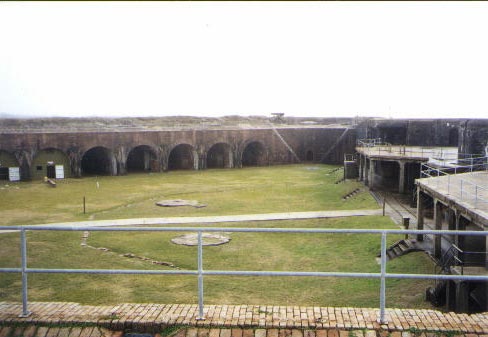 |
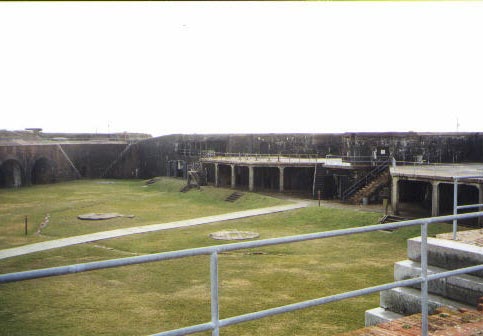 |
Fort Morgan, Alabama; photos taken in 1999, overlooking the batteries. |
Michael M. Bailey, Curator at Fort Morgan, was very helpful in considering the reasons why P.N. STONE might so abruptly quit the Army so soon after completing his year of training and accepting a higher position at Ft. Morgan. It may have had something to do with the isolation of Fort Morgan from the outside world; considered an “island outpost,” about 200 men were stationed there at the time, and the closest center of civilization was Mobile, Alabama, 35 miles away by boat. The “culture shock” of moving from relatively urban and urbane posts in New York and Virginia to those lonely, windswept beaches of white sand in the deepest South, on the very brim of the Gulf of Mexico, must’ve been considerable.
Additionally, there is always the possibility that P.N. STONE needed to leave because of business or family obligations. But even more intriguingly, Mr. Bailey reveals that “…during this period Fort Morgan may not have been a ‘happy fort.’ There appears to [have been] possible dissension, hostility or some other stress factor among the officers assigned to the post,” two of whom (a captain and a lieutenant) were removed due to mental illness (the captain ended up in the U.S. Government Hospital for the Insane in Washington). “If there were significant problems among the officers he [P.N. STONE] would have been in a position to have knowledge of them and decide that purchasing his discharge was his only way out of a bad situation.”31
Just over four months later, in September 1913, P.N. STONE was writing to the Adjutant General of the Army from Pittsfield, Massachusetts (c/o General Delivery), inquiring to know whether if he re-enlisted in the Coast Artillery Corps would he still retain his eligibility for the position of Master Gunner? The answer was yes, but he never re-entered the military.3, 4 Instead, he got a job with a railroad and was married the following July in the Bronx.
World War I service? According to a family member, he served in WWI (in the Army?), possibly overseas, where he contracted dyspnea, “a terrible infection of the lungs.” He had a deep indentation in his back from the surgery to clear out the infection, a souvenir of his wartime service, according to one family member.17 Additionally, on the 1930 census, someone has told the census-taker that Philip served as a veteran in World War I.43
But no confirmation of any WWI service has yet been found. His draft registration card filed in the Bronx, NYC on 5 June 191721 indicated that he wished to claim an exemption from the draft on account of his wife, a dependant. The draft classification book shows him being given the military rating of 4A (he was 31 years old) in February 1918 and as far as I can tell from the further lack of notations in the book, he was never called up for war service before the war ended on 11 November 1918. (Over 80% of WWI draft card registrants never did serve in the military.) I have located no military pension or compiled service records for him, and repeated written requests to the National Archives, the Veterans Administration, and elsewhere to search for possible WWI military service documents have turned up nothing. Based on these results, I believe he did not serve in the military during WWI. There were in fact periods of documented illness during his Coast Artillery Corps service that may have resulted in the serious scarring:
for the dates of Oct. 17-31 (or longer), 1908, Philip N. Stone was listed as “Sick in Quarters, Disability not in line of duty” at Ft. Totten, New York. The Company had been away to Fort H.G. Wright, New York, for small-arms practice from Oct. 10-21, when he became sick. Nine other men of the 100-man company, a relative epidemic, were also listed sick on the Muster Roll dated Oct. 31st.22 This illness, whatever it was and however it was contracted, may well have been severe enough to have left him scarred, particularly under the ministrations of an Army doctor.
for the dates of Aug. 9-11, 1910, inclusive, he was listed as “Sk in Hosp….in line of duty” at Ft. Totten.23
MARRIAGE date: July 1, 1914 Place: Civil ceremony at 4187 Third Avenue, New York City, Borough of the Bronx, New York. Philip Nelson Stone, resident of Pittsfield, Massachusetts, was 28 years old and gave his occupation as “brakeman” (a railroading position). Loretta Elsie EHMANN was 23, resident of 2128 Valentine Ave., the Bronx, where she lived with her widowed father and her brother. It was the first marriage for both of them. Peter Selveriekerl (sp? illegible) performed the ceremony, with Agnes McGill as witness. They were married again by a minister (J. Henry Hartman) on 20 April 1916 at 240 East Tremont Avenue in the Bronx. On this occasion Philip was 29 years old, gave his occupation as "Conductor" (with the railroad) and his residence as Waterbury, Connecticut (see marriage certificates).6, 48 The witnesses at this second ceremony were Herbert Ehmann, Loretta's brother, and Edna Fagan.
SPOUSE'S name in full: Loretta Elsie Ehmann Stone6, 10, 48
CHILDREN:
1. Muriel Adele Stone born 14 February 1924 in Gilboa, Schoharie Co., New York
2. Davis Philip Stone born 12 December 1925 in the Bronx, New York City, New York
SEPARATION: Legal separation took place in Chester, Orange County, New York sometime in the 1930s(?)27
DIVORCE date: January 29, 1965 Place: Uncontested divorce obtained and decree filed from the District Court, 138th Judicial District, Cameron County, Texas (Philip Stone vs. Loretta Stone, No. 44,528-B).10
DEATH date: at age 88 on 30 November 197411
Place: Died in his mobile home in a trailer park at 1 mile South Conway (being the “main drag,” also called Hwy 107), in a remote section of the town of Mission (Hidalgo County), Texas.11, 12, 13, 14, 15
Mission, Texas, where Philip Stone died, “is located in the Rio Grande Valley, is a semi-tropical region located about 7 miles north of the Mexican border. The population is close to 90 percent Hispanic. Main industries are oil, agriculture and tourism. The weather is hot in the summer and nice in the winter. Average rainfall is about 20" per year.”13
 |
Mission, Texas as it looked around the time Philip N. Stone lived there. |
His obituary14 in the December 4, 1974 issue of The Monitor read:
“PHILIP N. STONE, MISSION — Philip Stone, 88, was found dead at his home Monday. He was a native of New York. Survivors are two sisters, Mrs. Susan Barber of Springfield, Mass; and Mrs. Katherine De Celles of Northhampton, Mass. Burial was today in Laurel Hill Cemetery under the direction of the Virgil Wilson Funeral Home.”12
BURIAL date: December 4th (obituary)12, 14 or 5th (death certificate),11 1974. Place: Burial at Laurel Hill Cemetery, Mission, Texas.25 Plot was purchased in his name by him before he died, no date given.14 Cemetery is on North Holland Road in front of the Mission High School.13 (Latitude: 261328N, Longitude: 0981959W). Laurel Hill Cemetery is the main city cemetery. It is kept up nicely and is full of native trees. P.N. STONE is buried beside a live oak tree in the northwest corner of the cemetery.14 He died intestate and his estate was settled and he was given a Christian burial by the local court’s Estate Administrator.15 A U.S. government Veteran’s tombstone has been erected over the grave.
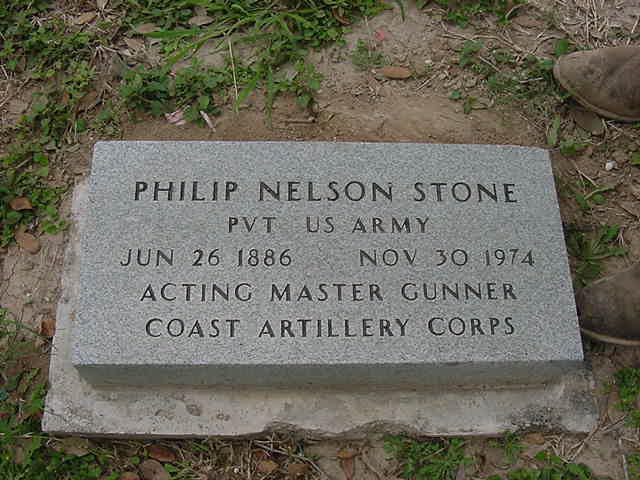 |
Philip N. Stone's gravemarker, Laurel Hill Cemetery,
|
RESIDENCES:
Town, County, State, Dates
Nyack, Rockland Co., New York -- Said to have been born there June 1886;7, 21, 47 No birth certificate can be located; his father was still there till circa 18908-4
Massachusetts -- 1891, brother Davis was born there
Cummington, Hampshire Co., Masssachusetts -- 1896, sister Katherine was born there; family on farm there 1900 census19
Ft. Slocum, Davids Island, New Rochelle, in western Long Island Sound (Westchester Co.?), New York – P.N. Stone enlisted there 26 August 19081
Fort Totten, Queens Co., New York – U.S. Army (C.A.C.) -- Sept. 1908-Aug. 191122, 23, 28
Fort Crockett, Galveston, Galveston Co., Texas – U.S. Army (C.A.C.) -- March-June 191123
Fort Monroe, Hampton Co., Virginia – U.S. Army (C.A.C.) -- Aug. 1911-Aug. 191223
Fort Morgan (Baldwin Co.?), Alabama – U. S. Army (C.A.C.) -- Aug. 1912-April 191324
Pittsfield, Berkshire Co., Massachusetts -- Sept. 1913 P.N. Stone’s letter to the Adjutant General;3 Also address of groom given on Bronx, New York marriage license, July 1, 19146
Waterbury, Connecticut? -- second marriage license, 20 April 191648
2128 Valentine Ave.,The Bronx (Bronx Co.), New York (his father-in-law's home) -- June 1917 WWI draft registration card;21 1920 U.S. census (Jan. 15)20
Gilboa, Schoharie Co., New York -- Feb. 1924; daughter born27 while P.N. Stone was working for the Board of Water Supply Police of New York City (guarding/policing construction camps for the reservoir system?)
New Hampton (Lat. 41.4N, Long. 74.4W), Orange Co., New York -- as of Dec. 1925 when his son was born27 at his father-in-law’s home in the Bronx
“Phillip…Stone of New York” -- Feb. 12, 1930 identified as a pallbearer at the funeral of his sister Evelyn’s husband, in Northampton, Massachusetts8.2-8
Sanford Avenue, Chester, Orange Co., New York -- April 1930 (census)43
Greycourt (just east of Chester), Orange Co., New York -- as of Jan. 1932 until at least Feb. 1933;26 to mid-1930s?
345 E. 86th St./Box 1078 Grand Central Station, New York City, New York -- Address given on Application for Social Security Account Number, signed 3 Sept. 1954; (he had retired 2 days earlier)
“Philip N. Stone of Brooklyn, NY” -- 8 September 1954; mentioned in the obituary of his sister, Evelyne Warriner, Northampton, Massachusetts8.2-9
Mexico? Texas? -- Retirement—?16, 17
Laredo, Webb Co., Texas -- 19 May 196030
Port Isabel?, Cameron Co., Texas -- late 1964, Jan. 196510, 17
Pharr, Hidalgo Co, Texas -- (Social Security Death Index listed this as his place of death and/or last address)
1 S. Mi. Conway, Mission, Hidalgo Co., Texas -- Sept.-Nov. 1974;11 his last residence and place of death
ADDITIONAL BIOGRAPHICAL DATA (baptism, religious affiliation, etc.):
Social Security No. 084-30-4897 (applied for at age 68 on Sept. 3, 1954).7
Had no discernable religious affiliation.
According to a family member, he was known as “Nels” to his family (parents and siblings).17
CENSUSES and WORK HISTORY:
According to his son, he was raised as a “poor farm boy” on one of “New England’s infamous rocky, hilly, infertile farms....One of many children, he knew hard work at an early age....”27
The 1900 Federal census19 (enumerated June 15th) shows the household of Edwin Stone living on a rented farm in Cummington (Hampshire Co.), MA (without street address), adjacent to the Walter Stone (Edwin’s brother) family, including:
STONE, Phillip [sic] N. - son, white, male, born June 1886, age 14, single. Born in New York; father born in Mass., mother born in Georgia. Occupation: “At school,” for previous 7 months; reads, writes, speaks English.
The 1910 Federal census28 (enumerated 15 & 16 April) shows him as a soldier at Fort Totten, New York (“Formerly Willets Point”), a Military Reservation in the Borough of Queens, New York City, New York, in the Barracks of 101st Company, Coast Artillery Corps, U.S. Army, as:
STONE, Philip M. [sic], Musician, male, white, age 20, single, born in New York, father born in Massachusetts, mother born in Georgia. Native language: “English—Are required to speak English before acceptance in the Army.” Trade or profession: “Soldiers.” Nature of business: “United States Army.” Able to read and write: “Yes—not accepted in Army if not able to” [read/write].
The 1920 census20 (taken Jan. 15) shows the following living at 2128 Valentine Ave. in the Bronx, New York:
EHMANN, OSCAR - Head of household; Owns own home/Mortgaged; age 58; widowed; able to read and write; born in New York; father and mother both born in Germany, with German as their mother tongue; able to speak English; occupation: retired builder.
EHMANN, HERBERT - Son; age 25; single; able to read and write; self and parents born in New York; able to speak English; occupation: stenographer at the Navy Dept., for wages.
STONE, PHILIP N. - Son-in-law; age 33; married; able to read and write; self born in New York; parents both born in the United States; speaks English; occupation: flagman on the railroad for wages.
STONE, LORETTA E. - Daughter; age 29; married; able to read and write; self and parents born in New York; speaks English; occupation: housekeeper.
Worked on the construction of the aqueduct into New York City17 [most probably the Schoharie Reservoir and/or Shandaken Tunnel near Gilboa, NY circa 1920-1924]:
According to recollections of his children, his daughter had been born in Gilboa, NY, where her father was working on the New York city watershed/reservoir system, either the Ashokan or some other part of the system then under construction. I learned through research that the Ashokan reservoir was finished before the daughter’s birth in 1924. Her father became a member of the New York City Employees’ Retirement System on 11 June 1923. He was living in Gilboa and working for the Board of Water Supply Police of New York City in February 1924.
Some internet research leads me to believe that the most likely part of the reservoir system he was working on was the Schoharie Resevoir near Gilboa, and/or the Shandaken Tunnel, as these projects were happening during the right time frame for him to have been there (circa 1920-1924). After the Ashokan reservoir system was completed (1907-1917), the Catskill aqueduct system was still insufficient for New York City’s water needs. In 1917 the village of Gilboa on Schoharie Creek was acquired, with 192 parcels and an area of 2,435 acres to build the Schoharie reservoir. When the 18-mile Shandaken tunnel was built (it was completed in 1923), it was the longest continuous tunnel in the world at the time, flowing under mountains to deliver the waters from the Schoharie into the Esopus Creek and then into the Ashokan Reservoir. The Schoharie Reservoir began to fill on 24 July 1926, obliterating what used to be the southern portion of the town of Gilboa and sinking the village of the same name.
On 12 Feb. 1930, 2 p.m. at the Florence Methodist Church and Spring Grove Cemetery in Florence/Northampton, Massachusetts, Philip was one of four pallbearer (along with his brother Davis, from Long Island) at the funeral of their sister Evelyn’s husband, Justin Bliss Warriner.8.2-8
1920s and 1930s: Was working as a “keeper” (guard) at the New Hampton (Orange County) men’s reformatory (“Hampton Farms”), 65 miles outside New York City, in December 1925; by January 1932 he had transferred to the position of keeper at the Greycourt women’s farm colony, the other New York City reformatory in Orange County, located near Chester, New York. (See photo of the “New York City Reformatory, New Hampton” where P.N. Stone worked at the bottom of this webpage.)
Fifteen years into his marriage, the 1930 census43 (taken 15 April) shows him living with wife Loretta and their two young children on Sanford Avenue in Chester Village, town of Chester, Orange County, New York:
STONE, PHILIP N., head of household, (home data: living in a home rented for $15/month, owns a radio in the home), male, white, age 43, married, age 28 when first married, did not attend school or college since 1 Sept. 1929, can read and write; self born in New York, parents born in the United States, speaks English; occupation: “Keeper”[i.e. prison guard]; industry “City farm” [or “farms”; these were the New York City Dept. of Correction work farms—the men’s facility in New Hampton, “New Hampton Farms,” and the “Women’s Farm Colony” in Greycourt]; employed for wages, presently employed; veteran of the World War [sic; WWI veteran status not documented]
The 1930 census also shows that the nearby “Women’s Farm Colony” on “Chester and Monroe dirt road” on 2 April housed 191 female prisoners and 30 male prisoners aged 22 to 69 years (many of them foreign born). Kathryn E. Mcquin was Warden, with eight female officers (three of them naturalized Irish-born) on her staff.44 The larger “New Hampton Farms Village” enumerated on the next day in Goshen township was described as a New York City Reformatory (institution) on Middletown Goshen State Road (also known as Goshen-Middletown State Road). It housed 438 male inmates between the ages of 16 and 29 (most were age 17-21) under the supervision of William A. Adams, Superintendent (a 39-year-old WWI veteran, living there with his wife, Margaret, their two small children and a housekeeper); Patrick Gallager, Warden (age 50, living there with his wife, Ellen); seven male “keepers” (guards: James Reynolds, Kearry Ashworth, Edward McBurney, Harold Evans, Joseph Amster, William Pikington, Edwin Soons,); two clerks (Edward Stollmer, Seymore Wieselthur); a physician (Alfred Rapp); a storekeeper (Herman Gribenski); two instructors (Peter McCun, Gabriel Wetmore), an engineer (Stephen Sanborn); a pumpman (Joel Coleman); a head cook (Alfred Henot); and a Prison Helper (Percy McDermont). [E.D. 36-16, pp. 1A-5A, T626, Roll 1632.] Philip Stone worked as a keeper at both of these institutions during the late 1920’s-early 1930’s.
He was mentioned in the following issues of “On Guard,” “The Only Magazine in America by Prison Keepers for Prison Keepers,” published monthly by the Prison Keepers Council of the New York City Dept. of Correction (“Chitchat” column)26:
From the January 1932 issue, page 7 under a heading “HAMPTON FARMS”
“Keeper Stone, who is attending school from Greycourt and formerly of here, is rushing a can. Let’s hope Deputy Warden Feely does not let him go to the dogs.”
[The “school” was the Keepers Training School down in NYC. “Hampton Farms” was the other Orange County-located facility of the NYC Dept. of Correction. The chitchat columns were full of insider jokes and wisecracks whose meanings were known only to those directly involved. “Rushing a can” was contemporary slang meaning to run out to fetch some beer; to “go to the dogs” meant to degenerate or go to ruin.]
From the January 1932 issue, page 8 under a heading “GREYCOURT”
“Phil Stone, the canteen toter, is spending a two weeks vacation after his eight weeks at keepers training school.”
[This item was the Greycourt column’s closing one-sentence paragraph after a very extended section (about 2/3rds of the column) on how Greycourt fared in various departmental shooting competitions.]
On page 12 of the November 1932 issue under the headline “WHAT THEY ARE THANKFUL FOR,” obviously a Thanksgiving Holiday feature:
“Keeper Stone that he is No. 1 on the head keepers lists.”
On Page 1 of the Jan.-Feb. 1933 issue, “Keeper Philip Stone, Greycourt” is listed with five other officers as tying for first place in the Commissioner’s Cup competition with a marksmanship score of 100%. In the shoot-off that followed, a fellow keeper from Greycourt won.
From the NYC Correction History Society’s website, a description of the Keepers School:
“Since it was organized the State of Massachusetts has started such a school and just recently the Federal Government also inaugurated one which was patterned very closely after our own. In fact we furnished the government with much information concerning the curriculum and the method we use…
“The course is an intensive one of eight weeks duration, half the day being devoted to instruction in various aspects of prison administration and the remaining half to physical training, drilling, swimming, jiu-jitsu, the handling of refractory prisoners and things of like nature…We are having this curriculum printed in booklet form for distribution, as we have received many requests from prison officials throughout the country…nothing that the Department has ever done, at least in recent years, has excited such much widespread interest outside of New York.
“The school last year was held in the Police Academy and police instructors assisted our own men in the operation of the school. This year (1930), however, we have moved the school to a large room at the Penitentiary on Welfare Island and have placed it in complete control of our own officials. We are also working on a plan to take over the physical instruction of our men, hitherto given by members of the Police Department, so that we soon will be able to go ‘on our own’ in this department of the school as in others.” [http://www.correctionhistory.org]
New York City celebrated the 25th anniversary of its consolidation into a five-borough municipality known as Greater New York in 1923 and the Silver Jubilee celebration featured an “educational exposition” that ran from May 26 to June 23 in the Grand Central Palace on Lexington Ave. between 46th and 47th Streets. The exposition featured many exhibits, booths, and models, including:
A model of the New York City Reformatory, New Hampton, Orange County, NY (“All inmates of the reformatory type, between the ages of 16 and 30 years, are transferred to this institution. The principal activity here is farm work. The approximate value of the crops raised annually is between $50,000 and $75,000.”). [The New Hampton facility was considered in its day to be a model of enlightened prison reform.]
Booth No. 17 at the exposition featured a farm and floral display described in the guide to the exposition as: “featuring a panoramic view of the New York City Reformatory, New Hampton, Orange County, New York, soil extending from picture to railing. This panoramic view was painted by an inmate. Hills in picture are extended in soil to railing, containing products and method of production. Two manikins are displayed in the act of working on the farm. Other types of produce grown on the farm are also displayed. The railing installed on outer aisle is typical of a farm fence. It was constructed by inmates at the New York City Reformatory. At the rear of panoramic view, displaying the New York City Reformatory, is exhibited numerous transparencies, featuring sixty institutional views of the department. There is also displayed in this booth some of the work accomplished by the women inmates at the Correction Hospital.”
The Silver Jubilee exposition also featured a model of Warwick Dairy Farm, Warwick, and the New York City Women’s Farm Colony, Greycourt, Orange County, New York: “Warwick is an Honor Camp, and only such inmates are transferred to this place from the New York City Reformatory at New Hampton as have earned this opportunity by good work and conduct. Here we have no prison bars, cells nor locks. The Women’s Farm Colony is used at present as an Honor Camp for inmates from the New York City Reformatory, of a type similar to those transferred to the Warwick Dairy Farm. They are employed chiefly in farm work and other manual labor in connection with the completion of this institution. It is proposed, when this institution is finally completed, that women prisoners will be transferred here from the Correction Hospital on Welfare Island.”
“The site for the present Reformatory in New Hampton, Orange County, New York, was acquired in 1913. The first boys were moved there on March 8, 1914. The young men sent there, all on indeterminate sentences, had training facilities in many fields. When the Reformatory at New Hampton was completed in 1916, the Harts Island institution was then renamed Reformatory Prison.”
The New York City women’s farm colony at Greycourt in Orange County received its first female inmates in 1924.
General information about “The Tombs” prison in New York City, where Philip N. Stone was reportedly working as a deputy warden at the time he retired (1954):
According to Roger Whitehouse’s book, New York: Sunshine and Shadow, “The original Tombs prison [completed in 1838, and located in the block of Manhattan bordered by Centre, Franklin, Elm, and Leonard Streets, was an]...imposing white-granite building, which contained several courtrooms and the city’s cells and gallows [and] was the subject of much morbid curiosity and fame in its time. Although it assumed its name from the style of Egyptian funerary architecture in which it was built, it has always been shamefully symbolic of the fate of its inmates. The observations made of it by Dickens in 1842 [from his “American Notes”] have sadly been echoed many times since then in all of the three city jails to bear the same name....”
According to the New York City Correction History website, the original Tombs Prison was constructed with 148 double cells, giving a capacity for 296 prisoners, and existed till 1897. The second Tombs opened in 1902 consisting of a main building and two annexes, connected by the “Bridge of Sighs” with the Criminal Courts Building on the Franklin Street side; normal capacity was 591 cells; a massive stone structure with steel cells, used until 1941. [http://www.correctionhistory.org]
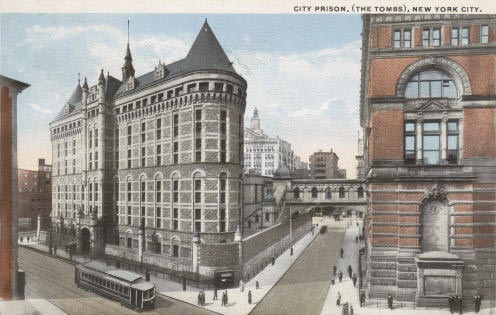 |
"The Tombs" prison in New York City, circa 1910. |
It was for many years (up into the 20th century) the city’s main prison and collection tank for all miscreants and misfortunates arrested on the streets or rounded up at the various police precinct houses. Hardened criminals, vagrants, drunks, prostitutes, and runaway or abandoned children were thrown in together. One of its interior walkways, called “The Bridge of Sighs,” was infamous as the symbolic “last mile” walked by those on their way to execution at the gallows. On these days the adjacent buildings in the neighborhood were said to be “black with people” hanging off of and out of the windows to catch a glimpse from over the imposing outer Tombs’ wall. (Lights and Shadows of New York Life, by James D. McCabe, Jr., page 233.)
In 1872 the prison was already functioning at double its capacity. In 1870, “49,423 people were confined for various periods of times in the Tombs.” (ibid., page 238.) The facility also housed the courts that disposed of the criminal cases.
A new prison, known as the City Prison Manhattan, was occupied on Sunday, November 8, 1941, located at 125 White Street, adjacent to and connected by two bridges to the new Criminal Courts Building at 100 Centre Street. On the site of the present prison once stood the gallows, stocks, and public flogging areas of an earlier era. [http://www.correctionhistory.org]
In 1981 the original Tombs was gutted by order of Federal Judge Morris Laskey, who “forced the city to spend $20 million to fix up the old Tombs jail....” (The Rise and Fall of New York City, by Roger Starr, page 123.) Standing on the old site, at 100 Centre Street in downtown Manhattan (near City Hall, and the Manhattan end of the Brooklyn Bridge) is the new Manhattan Detention Center.
From Manhattan ‘45, by Jan Morris (Oxford University Press, NY, 1987): “...and almost the only modern [in 1945] installations of Law and Order were the houses of detention—the men’s within the Art Deco building dreadfully called the Tombs,....” ibid., footnote: “After a nasty riot in the Tombs in 1974 the men’s prison was removed to another offshore island, Riker’s....” (p. 73.)
Today the Tombs is called the Manhattan Detention Complex, located at 125 White Street in lower Manhattan. The south tower, where the Tombs was originally, was totally remodeled in 1983. The north tower opened in 1990; they are connected by an enclosed bridgeway. On Dec. 12, 2001 the complex was renamed the Bernard B. Kerick Compex.
REFERENCES AND SOURCES USED FOR RESEARCH AND VERIFICATION:
Many personal conversations and correspondence over the years with various family members.
4-1 Register of Enlistments [1908], Stone, Philip N., No. 3374, page 152; Registers of Enlistments in the U.S. Army 1798-1914, microfilm publication M233 (Washington: National Archives), roll 64.
4-2 Register of Enlistments [1911], Stone, Philip N., No. 4419, page 305; Registers of Enlistments in the U.S. Army 1798-1914, microfilm publication M233 (Washington: National Archives), roll 68.
4-3 Letter from Philip N. Stone (Pittsfield, Mass.) to The Adjutant General of the Army, Washington, D.C., 29 September 1913; original is in the Adjutant General’s Office Document File at the National Archives, Washington, D.C.
4-4 Letter from E. M. Weaver, Chief of Coast Artillery Division, to The Adjutant General, U.S.A., 11 October 1913. Original is in the Adjutant General’s Office Document File at the National Archives, Washington, D.C.
4-5 Letter from David H. Wallace, National Archives and Records Administration (Washington, DC 20408) to Michelle Stone, 23 March 1998, interpreting Register of U.S. Army Enlistments information concerning Philip N. Stone.
4-7 Philip Nelson Stone, no. 084-30-4897, Application for Social Security Account Number, dated 3 September 1954, Treasury Department, Internal Revenue Service, obtained from the Social Security Administration, Baltimore, MD.
4-8 Numident for Philip Stone, no. 084-30-4897. Obtained from the Social Security Administration, Baltimore, MD.
4-9 Letter from Vincent Sanudo of the Department of Health & Human Services, Social Security Administration (Baltimore, MD 21235), 15 Nov. 1994. Cover letter for documents and notification that no claim files exist.
4-10 Philip Stone vs. Loretta Stone, Decree of Divorce, No. 44,528-B (29 January 1965), in the District Court Records of Cameron County, Texas.
4-11 Philip N. Stone, death certificate no. 92195 (1974), Texas Department of Public Health, Austin.
4-12 Philip Stone obituary, The Monitor, McAllen, Texas, 4 December 1974, page 2, column 2.
4-13 Email correspondence.
4-14 Email correspondence.
4-15 Letter from Donald E. Wilson to Michelle Stone, undated (postmarked 26 October 1994. Mr. Wilson was appointed administrator of the estate and arranged for and attended the funeral and burial of Philip N. Stone.
4-16 Philip N. Stone estate, Hidalgo County Court file no. 11,407, Clerk’s office, Edinburg, Texas.
4-17 Telephone conversation with a relative of P.N. Stone.
4-18 Excerpt from Michelle Stone’s trip log, visit to Syracuse, NY.
4-19 Edwin B. Stone household, 1900 U.S. census, Hampshire County, Massachusetts, population schedule, Cummington town, enumeration district 618, volume 34, sheet 5, dwelling 134, family 136; National Archives micropublication T623, roll 653.
4-20 Oscar Ehmann household, 1920 U.S. census, Bronx County, New York, population schedule, New York City, enumeration district 423, supervisor’s district 2, sheet 13A, dwelling 89, family 263; National Archives micropublication T625, roll 1142.
4-21 Philip N. Stone, World War I draft registration card, dated 5 June 1917, Bronx County, New York; Record Group 163, M1509 Series, National Archives-Southeast Region, East Point, Georgia.
4-22 Muster Rolls of the 167th Company of the Coast Artillery Corps, 31 August 1908-28 February 1910, box 1554, Regular Army Muster Rolls of the 167th Co. C.A.C. (31 October 1907-31 August 1912) and 168th Co. C.A.C. (31 October 1907-31 October 1912), Office of the Adjutant General, Record Group 94, National Archives, Washington.
4-23 Muster Rolls of the 101st Company of the Coast Artillery Corps, 31 December 1908-31 August 1912, box 1498, Regular Army Muster Rolls of the 101st Co. C.A.C. (31 August 1904-31 October 1912), Office of the Adjutant General, Record Group 94, National Archives, Washington.
4-24 Muster Rolls of the 99th Company of the Coast Artillery Corps, 30 June 1912-31 October 1912, box 1496, Regular Army Muster Rolls of the 99th Co. C.A.C. (31 December 1908-31 October 1912) and the 100th Co. C.A.C. (9 August 1901-31 August 1906), Office of the Adjutant General, Record Group 94, National Archives, Washington.
4-25 Letter from Blanca Garza of the Vital Statistics Department of the City of Mission to Michelle Stone, 22 April 1998. Location of gravesite of Philip Nelson Stone in Laurel Hill Cemetery, and cover letter for enclosed uncertified death certificate.
4-26 Email correspondence with Thomas C. McCarthy <NYCHS@aol.com> (General Secretary, New York Correction History Society, http://www.correctionhistory.org; Director of Historical Services, Correction Academy, New York City Dept. of Correction, 66-26 Metropolitan Ave., Middle Village, NY 11379) from 2 May 2002 to 4 May 2002, discussing Philip N. Stone’s work history as a “keeper” with the New York City Department of Corrections.
4-27 Stone, Dave. “First Memories.” 1990; Canyon Country, California.
4-28 Philip M. [sic] Stone, Musician, in the Barracks of 101st Company, Coast Artillery Corps, U.S. Army at Fort Totten, New York (“Formerly Willets Point), a Military Reservation, 1910 U.S. census, Borough of Queens, New York City, New York, population schedule, enumeration district 1252, sheet 2A, National Archives micropublication T624, roll 1066.
4-29 Classification Books; Box 53, Reel 66, Records of Local Draft Boards, 1917-1919; Records of the Selective Service System (World War I), Record Group 163; National Archives and Records Administration-Southeast Region (Atlanta). Photocopies sent to M. Stone in April 1999 of two pages of classification book showing Registrant Philip Nelson Stone, Order No. 3622, Serial no. 710, classified 4A, notification mailed to him 14 Feb. 1918.
4-30 Letter from Philip Stone (Loredo, Texas) to S.L. Stone, 19 May 1960. (Photocopy).
4-31 Letter from Michael M. Bailey, Museum Curator, Fort Morgan State Historical Site/Alabama Historical Commission, 10 February 1999.
4-32 Menu (photocopy) of Christmas 1912 dinner of the 170th Company Coast Artillery Corps, Fort Morgan, Alabama. (Enclosure with letter 4-31 above.)
4-33 170th Co. Barracks photograph, undated (between 1905-1923), from the collection of the Fort Morgan State Historical Site/Alabama Historical Commission. (Photocopy) (Enclosure with letter 4-31 above.)
4-34 99. Co. Camp photograph, undated (between 1905-1923), from the collection of the Fort Morgan State Historical Site/Alabama Historical Commission. (Photocopy) (Enclosure with letter 4-31 above.)
4-35 Stone, Michelle. “Notes On My Visit to Ft. Morgan, Alabama on Sunday, 19 January 1999,” 1999, revised 2002.
4-36 Stone, Michelle. “Dave Stone Remembered,” 2002.
4-37 Letter from David J. Johnson, Museum Technician at the Casemate Museum, Fort Monroe (P.O. Box 51341, Fort Monroe, VA 23651) to Michelle Stone, 28 February 1999.
4-38 Fort Monroe, Virginia: Dept. of Enlisted Specialists, Coast Artillery School, circa 1910, montage of photos 8-1/2 x 11”, from the Casemate Museum, Fort Monroe, Virginia (enclosure with letter 4-37 above).
4-39 Fort Monroe Guide Book, compiled by The Casemate Museum, Ft. Monroe Va., 1993 (enclosure with letter 4-37 above).
4-40 Photocopy of page from Post Return, Coast Artillery School, 1911, enlisted men, Fort Monroe, showing Stone, Philip N., line 18 (enclosure with letter 4-37 above).
4-41 Unidentified copy (page 61, The United States Artillery School), enclosure with letter 4-37 above.
4-42 Annual Report of the Commandant of the Coast Artillery School, Fort Monroe, Virginia, 1912; Coast Artillery School Press, Fort Monroe, Virginia. (selected photocopied pages, enclosed with letter 4-37 above).
4-43 Philip N. Stone household, 1930 U.S. census, Orange County, New York, population schedule, Town of Chester, Chester Village, enumeration district 36-3, sheet 8B, dwelling 205, family 218; National Archives micropublication T626, roll 1632.
4-44 Women’s Farm Colony, 1930 U.S. census, Orange County, New York, population schedule (institution), Town of Chester, enumeration district 36-4, sheets 1A-2A, National Archives micropublication T626, roll 1632.
4-45 Telephone conversation with a relative of P.N. Stone.
4-46 Letter from Legal Affairs Department of the New York City Employees’ Retirement System (335 Adams St., Suite 2300, Brooklyn, NY 11201-3751), 10 July 2002, giving dates of entry and retirement of Philip N. Stone with the NYCERS system and confirming his pension ended as of the date of his death.
4-47 Letter from Dr. Pelham K. Mead, former historian of Grace Episcopal Church, 8 November 2003, giving baptism information for Philip Nelson Stone and Evelyn Cordelia Stone.
Other Sources Referred to in this Worksheet:
4.1-1 Telephone conversation with a relative of P.N. Stone.
8-4 Edwin B. Stone entry, Nyack [NY] [City] Directory for the year 1890-91, page 94, forwarded by The Nyack Library.
8.2-8 Justin B. Warriner funeral notice, Hampshire Gazette, Northampton, Massachusetts, 12 February 1930.
8.2-9 Mrs. Evelyne Warriner obituary, Hampshire Gazette, Northampton, Massachusetts, 8 September 1954, page 3.
Books:
Grafton, John. New York in the Nineteenth Century: 321 Engravings from Harper’s Weekly and Other Contemporary Sources. 1977. New York: Dover Publications, Inc.
McCabe, James D., Jr. “The Tombs.” In Lights and Shadows of New York Life; or, Sights and Sensations of the Great City. 1872. Reprint, New York: Farrar, Straus and Giroux, 1970.
Morris, Jan. Manhattan ‘45. 1987. New York: Oxford University Press.
Starr, Roger. “Paying for the Crime.” In The Rise and Fall of New York City. 1985. New York: Basic Books, Inc.
Whitehouse, Roger. New York: Sunshine and Shadow: A photographic record of the city and its people from 1850 to 1915. 1974. New York: Harper & Row Publishers.
Websites:
<http://www.correctionhistory.org>, City of New York Correction Department history and archives, May 2002.
<http://www.nyu.edu/greyart/exhibits/shahn/rikers.htm>, and see also <http://www.artmuseums.harvard.edu/Shahn/exhibitiontour/prikers.html>, “Ben Shahn’s New York: The Photography of Modern Times; Rickers Island Penitentiary Mural Project,” (photo, 1934: untitled; New York City Reformatory boys, New Hampton, New York); 16 May 2002.
<http://www.westchesterlandtrust.org/watershed/>, NYC Watershed Retrospective slideshow [Ashokan Reservoir], 16 July 2002.
<http://www.catskillcenter.org/programs/csp.H20/Lesson4/lesson4.htm>, “Lesson 4: Summary: New York City Watershed / New York City’s Need for Water” [Schoharie Reservoir], 16 July 2002.
SOURCES CHECKED, NOTHING FOUND:
1. New York State Archives Record Unit, index card file of WWI veterans enlisted from New York State; New York State Library, Albany, NY. File checked for me by Compuserve Roots Forum email correspondent, Robert F. Blot, Oct., 1994. No card for Philip Nelson Stone. Later request by me by mail to NY State Archives War Service Records for his “World War I Summary Service Card” wherein I supplied all his CAC info and WWI draft card info came back marked “We searched + did not locate!” 8 July 1998.
2. General Pension Index, National Archives Regional Branch, San Francisco—checked by a Compuserve Roots Forum email correspondent in Oct., 1994 (Washington D.C. microfilm is too light to read!). No Edwin B. Stone or Philip Nelson Stone.
3. Repeated requests sent by me in 1998 and 2000) for Philip Stone’s WWI or any other military service records to the National Archives and Records Adminstration (Military Personnel Records Center, 9700 page Ave., St. Louis, MO 63132-5100), including to the Records Reconstruction Branch, have been returned marked “We are unable to identify a military service record from the information given” (last answer received 1 Aug. 2000), even though I did send them full information on his Coastal Artillery Corps service, and copy of his WWI draft registration card. I had also checked twice with the Department of Veterans Affairs (Regional Office, 1120 Vermont Ave. NW, Washington, D.C. 20421-1111) to see if they could find any records of a military pension or medical services given to him, and their letter back stated: “We have used all of the available information and we are unable to locate any records for Philip N. Stone” (Sept. 2, 1998, letter from A. Vangordon, 372/27).
4. Letter 7 May 1998 from Office of the County Clerk, County of Bronx (Bronx County Bldg., 851 Grand Concourse, Bronx, NY 10451) states in answer to my request for possible copy of P.N. Stone’s WWI veteran discharge papers: “Please be advised that a search of our records show nothing on file in this office for Philip Nelson Stone.”
5. No NY City Dept. of Correction pension card is available from personnel services of the NY City Dept. of Correction (Mr. McCarthy checked for me, May 2002).26 He also found no additional newsletter references to P.N. Stone for years 1950’s and 1960’s (under Commissioner Anna M. Kross).
6. No birth certificate can be found. (Form letter from Village Clerk’s Office, Village of Nyack, 9 N. Broadway, Nyack, NY 10969-2697 in response to my letter dated 16 Feb. 1999: “Record not on file.”) Earlier request of the NY State Dept. of Health, Vital Records Section, in Albany, produced similar response. (Form letter from Certification Unit, Empire State Plaza, Albany, NY 12237-0023 dated 16 Sept. 1998, certifies that after a diligent search for birth record of Philip N. Stone, no record has been found.) Search by Meva Hook, volunteer researcher of the Berkshire Family History Association, Inc. turned up nothing among the Massachusetts Vital Records she checked (May 1999).
No records of legal separation kept by the Town of Chester (letter from Elizabeth A. Reilly, Town Clerk, 20 June 2002) or held by the Town Historian.
7. I have no photos of this man and would appreciate receiving any.
Rev. November 2013
| Home |